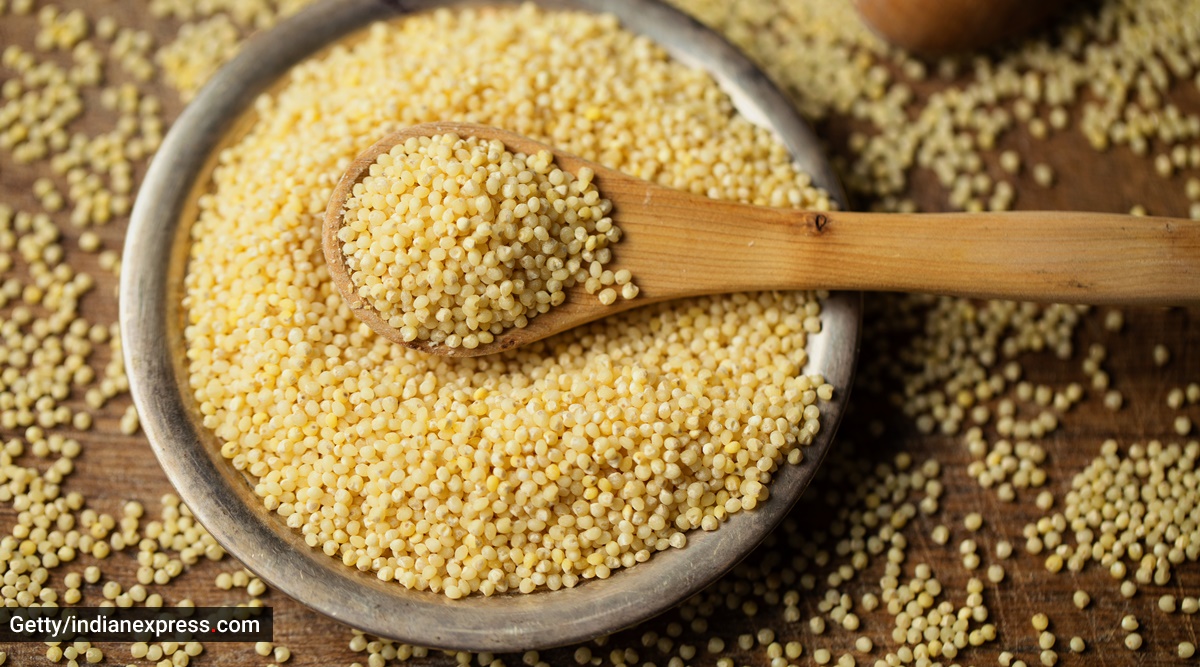📣 For more lifestyle news, click here to join our WhatsApp Channel and also follow us on Instagram
Can foxtail millet or kagni help ‘stabilise glucose release, reduce diabetes prevalence’?
It is important to note that the effectiveness of foxtail millet may vary from person to person, said Ushakiran Sisodia, registered dietician and clinical nutritionist, Nanavati Max Super Speciality Hospital, Mumbai
 Here's what to keep in mind (Source: Getty Images/Thinkstock)
Here's what to keep in mind (Source: Getty Images/Thinkstock)With 2023 being observed as the International Year of Millets, social media is abound with facts, figures, and tips about millets, an age-old grain considered to be extremely good for health. As such, we came across yet another Twitter post that detailed the use of foxtail millet or kagni and its numerous properties.
“Foxtail millets are rich in Omega-3 and Omega-6 fatty acids, rejuvenate nerves, help cure epilepsy, stabilise glucose release, reduce diabetes prevalence, and provide a good source of magnesium,” the post read.
Foxtail millets are rich in Omega-3 and Omega-6 fatty acids, rejuvenate nerves, help cure epilepsy, stabilise glucose release, reduce diabetes prevalence, and provide a good source of magnesium. #ShreeAnna #IYM2023 pic.twitter.com/4wMH3drbMX
— International Year Of Millets 2023 (@IYM2023) May 22, 2023
Is it true?
Experts suggest that the magnesium in foxtail millet stimulates the level of insulin and thus improves the uptake of glucose by the body cells. This also is effective in the management of type 2 diabetes, said Garima Goyal, a registered dietitian.
Concurred Ushakiran Sisodia, registered dietician and clinical nutritionist, Nanavati Max Super Speciality Hospital, Mumbai, and said that the low glycemic index of this type of millet means that it is “digested and absorbed slowly, resulting in a gradual release of glucose into the bloodstream”. “This property helps maintain stable blood sugar levels and prevents sudden spikes,” Sisodia told indianexpress.com.
Adequate magnesium levels can indeed improve insulin sensitivity and enhance glucose control, she added.
 Here’s why you should have foxtail millet (Source: Getty Images/Thinkstock)
Here’s why you should have foxtail millet (Source: Getty Images/Thinkstock)
What more?
Millet, including foxtail millet, is rich in dietary fibre, which includes both soluble and insoluble fibres. “Soluble fiber forms a gel-like substance in the digestive system, slowing down carbohydrate absorption and regulating blood sugar levels. Insoluble fibre, on the other hand, aids in proper digestion and prevents sudden blood sugar fluctuations,” said Sisodia.
What to keep in mind?
It is important to note that the effectiveness of foxtail millet may vary from person to person, Sisodia mentioned. “Therefore, it is advisable to consult with a diabetologist or registered dietitian for personalised dietary advice regarding glucose control and the inclusion of foxtail millet in your diet,” said Sisodia.
Here’s a recipe from Goyal that you can try.
Foxtail uttapam recipe
Ingredients
30g – Foxtail millet
15g – Urad dal
15g – Toor dal
1 tsp – Methi seeds
Salt to taste
1 tsp – Oil
½ – Onion, chopped
1 – Green chilli, chopped
5-6 – Coriander leaves
Method
*In a bowl, add one cup foxtail millet, a quarter cup of urad dal, two teaspoons of toor dal, and a quarter teaspoon of methi seeds.
*Soak in water for about six hours. Wash and drain the water thoroughly.
*Grind to a batter in a wet grinder or a mixer jar.
*Add salt and mix. Allow it to ferment overnight.
*Once fermented, pour a ladle full of batter into the dosa pan. Top it up with chopped onions, green chillies, and coriander leaves.
*Drizzle oil and cook on both sides.
*Serve with any accompaniments like chutneys.
📣 For more lifestyle news, follow us on Instagram | Twitter | Facebook and don’t miss out on the latest updates!
📣 For more lifestyle news, click here to join our WhatsApp Channel and also follow us on Instagram

Photos





- 01
- 02
- 03
- 04
- 05





















